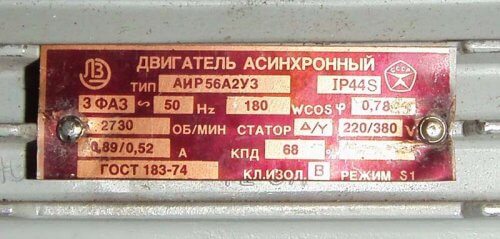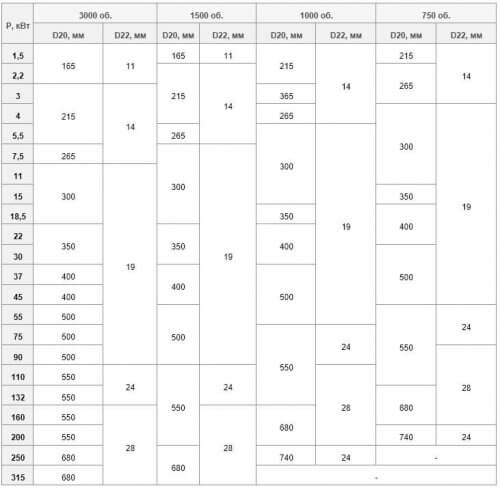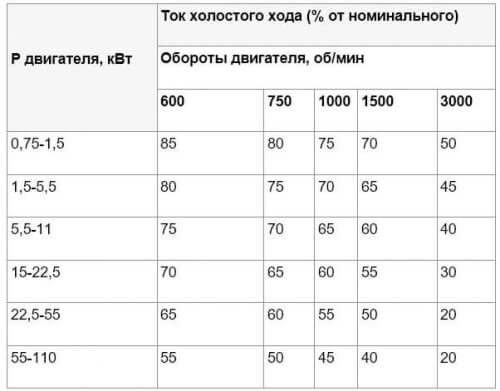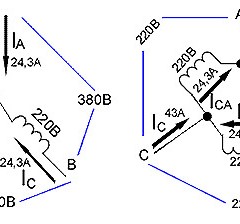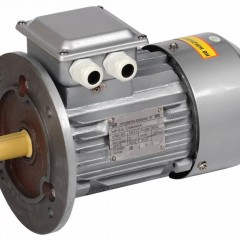How to determine motor power with and without a tag - an overview of the techniques
First look at the tag.
The easiest way is to determine the engine power by the nameplate (it is also called a plate or tag). First of all, it is worth remembering that the number indicated on the tag is the mechanical power on the shaft, the so-called R2. To find the active electrical P1 (which your counter will take into account), it needs to be divided by efficiency (η), and to find the full S, it’s also divided by COS, you will find them on the same nameplate.
P1 = P2 / η = 180 / 0.68 = 265 (W)
S = P1 / cosФ = 265 / 0.78 = 340 (W)
And if only current is indicated, you can determine the total power by the standard formula for three-phase circuits:
S = UI * 1.73
If according to the example of the above label, then:
S = 380 * 0.52 * 1.73 = 341 (VA)
Then active:
P1 = S * cos Φ = 341 * 0.78 = 266 (W)
And mechanical P2 on the shaft:
P2 = P1 * η = 180.8 (W)
As you can see, the results of calculations for current and voltage coincided with the numbers indicated on the plate. According to the nameplate, you can also determine other parameters of the electric motor, such as rated voltage, current, revolutions per minute.
Compare overall dimensions
If there is no plate or it is difficult to read something on it, then you can determine the power of an asynchronous electric motor without a passport in terms of dimensions, namely the diameter of the shaft.
This method of determination is used in practice more often than the others, since you only need to measure the shaft with a caliper and do not need to connect to the network. After measuring the diameter, the obtained values are compared with the table and determine the approximate power. This method allows you to get fairly accurate specifications without a tag. The table for this is shown below.
This method of determining the electric motor power by dimensions (by rotor) is suitable for both three-phase and single-phase induction motors. Note the “P” is indicated in kW (kilowatts), as is customary in electrical engineering, and not in physics - in watts.
If for some reason the data from this table is not suitable for you, then there is another way to find out the electric motor power by overall dimensions, you need to measure:
- shaft diameter;
- its rotation frequency (the number of pairs of poles);
- mounting dimensions;
- the diameter of the flange or the width of the mounting legs;
- height to the center of the shaft;
- motor length (without protruding shaft).
And compare this data with the dimensions of electric machines of a single series 4A, AIR, A, AO.They can be found in various directories or catalogs of companies that produce them.
To determine the engine power of the widespread AIR series by the mounting holes on the legs, use this table.
Use the following data to determine motor power from the diameter of the flange (D20) and the diameter of the mounting holes for the flange (D22):
Over time and practice, you will learn to approximately determine the power of the engine in appearance, mentally comparing it with those you have encountered before, but for this you need to know a number of standard ratings of electric motors: 0.25; 0.37; 0.55; 0.75; 1.1; 1.5; 2.2; 3.0; 4.0; 5.5; 7.5; eleven; fifteen; 18.5; 22; thirty; 37; 45; 55; 75 kW.
Estimated calculation of idling current and voltage
You can determine the power of the electric motor by current or, as amateurs say, "by amperage." But to measure the current when the machine is under load in order to find out its rated power is wrong, because you can’t know if it works under rated load, in overload, or vice versa is underloaded. The stator current depends on the load. This means that you are not measuring the rated current, but the current consumption at that moment.
So, you need to measure the idle current, that is, when the engine is running without load. Before you measure anything, in order to get the right data, you need it to work for a while, namely 0.5-1 hour for engines with power up to 100 kW and 1-2 hours - over 100 kW. After measurement, from the table, find out the typical deviations of Ixx from Inom as a percentage and calculate the estimated Inom.
Let's give an example, let's say you measured the current, it turned out to be 5 amperes. We evaluate the engine power “by eye”, suppose that it is quite large, and you assume that it is more than 5 kW. At the same time, it is a “three-thousander”, that is, its shaft rotates at a frequency of 3000 rpm. Then the measured open circuit current is 40% (or 0.4) of the rated current. To find out the rated current, you need to divide Ixx by percent from the table:
Inom = Ixx / 0.4 = 5 / 0.4 = 12.5A
Then the full and active power can be determined by the formulas:
S = UI * 1.73 = 380 * 12.5 * 1.73 = 8217 W = 8.2 kW.
We assume that the cos Φ of the engine is 0.85, and its efficiency is 0.8, then the active P1 is:
P = Iav * Usr * 1.73 * cosf * Efficiency = 12.5 * 380 * 1.73 * 0.85 * 0.8 = 5.5 kW
True, standard asynchronous three-phase motors with such parameters do not exist, the numbers were taken only as an example, but in the above method you can find out the motor power, knowing the current and voltage.
Calculation of speed and torque
To select the engine for a particular mechanism, you can determine the engine power by the torque and the number of revolutions that are required on the shaft. To do this, use the formula:
P = M * n / 9550,
where M is the moment, n is the number of revolutions, 9550 is the coefficient.
Conclusion
We examined the main methods for determining the power of an electric motor. There are other methods, for example, on the resistance of the windings, but it may not be accurate, since after rewinding it may not correspond to the passport data. And in order to accurately measure the resistance of the stator windings of powerful motors, precise measuring instruments, the so-called measuring bridge, are needed, or measurements are made using the voltmeter-ammeter method. What nobody will do in practice, and it’s impossible to make such measurements with a multimeter.
The method of determining the parameters of the motor by weight can also not be called accurate, it consists in the fact that, on average, the weight of the asynchronous motor is:
- for 3000 rpm - 7-9 kg per 1 kW;
- for 1500 rpm - 11-13 kg / kW;
- For 1000 rpm - 14-15 kg / kW.
But it’s completely impossible to call it exact, the cases of modern electric motors are made of aluminum and are lighter up to 30%, compared to the old Soviet ones, while the protected electric motor will weigh more than its unprotected counterpart. Therefore, this method, although it has the right to life, is more like fortune-telling on coffee grounds.
Perhaps the simplest definition of electric motor power is by size, shaft diameter, etc. with subsequent comparison with the catalog data of engines of the same series.
Related materials:

